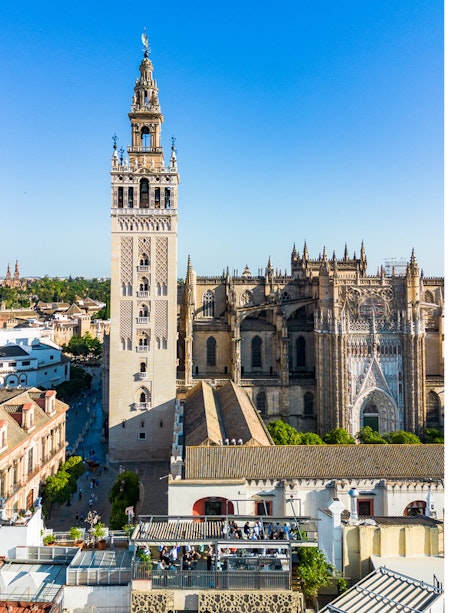

The Old Town is home to Seville's three UNESCO World Heritage monuments. The first one is the Cathedral of Santa María de la Sede, the gothic temple with the largest surface in the world and symbol of the city. Built on the site of the former Great Mosque of the 12th century, it preserves its old minaret—the current Giralda—and the Patio de los Naranjos (Orange Trees Courtyard).
At the panoramic bar La Terraza del EME, located facing the Cathedral, you can enjoy one of the best views of the city while sipping a cocktail. Calle Alemanes, 27.
Just a few meters from the Cathedral stands the "monument of monuments": the imposing Royal Palace and its beautiful gardens (chosen as "Game of Thrones" location). This former Muslim fortress (10th century) served as a royal residence for centuries and still houses official visits of the Spanish monarchy. Its blend of Islamic, Gothic, Mudéjar, and Renaissance styles reflects its exceptional historical and artistic value.

And next to the Alcázar, you will find the third World Heritage Monument: The General Archive of the Indies was created in 1785 by the wish of King Charles III with the aim of centralizing in one place the documentation relating to the administration of the Spanish overseas territories in America and the Philippines between the 15th and 19th centuries.
Mateos Gagos Street, the lively atmosphere on the terraces around Santa Maria Blanca Street, picturesque Santa Cruz, Doña Elvira or Los Venerables Squares, or the historical "Callejón del Agua" (Water Alley) where the water that supplied the Alcázar Royal Palace gardens circulated in the past) are only some of the beautiful sights in the popular Santa Cruz district, the ancient Jewish Quarter.
Stop by Maestro Wine Cellar to enjoy their local wines and tapas on the famous "Cuesta del Bacalao" (Cod Hill). Calle Argote de Molina, 29.

After the discovery of the Americans (1492) and for several centuries, the Arenal was the main port for commerce between Spain and the New World. Nowadays, it’s a monumental and cultural district. Between San Telmo and Triana Bridges, it’s worth to enjoy the Guadalquivir River bank (Columbus Avenue), the Golden Tower (primitive Arab bastion and current naval museum) or the Royal Maestranza bullring and grab a bite on the centenary neighborhood taverns (Garcia Vinuesa Street).
Don't miss the Monument to Tolerance by Basque sculptor Eduardo Chilida on the Muelle de la Sal, inaugurated on the occasion of the Universal Exhibition of Seville (1992).
Crossing the Triana Bridge takes you to the opposite bank of the river and to Seville's most popular neighborhood, the birthplace of local artists. The Mercado de Abastos (Central Market), the Triana Ceramics Center, the Royal Parish Church of Santa Ana, the Basilica of the Mariners, and the tapas bars on Betis, Asunción, or Castilla streets are just a few recommendations to discover of this lively area.

Maria Luisa Park is the city's oasis, with 34 hectares of greenery ideal for a shady stroll. The impressive Mudéjar Pavilion (one of the former pavilions that housed the Ibero-American Exposition) contains the Museum of Arts and Popular Customs of Seville. And opposite the park, the monumental Plaza de España invites you to take a delightful boat ride.
The shopping area is located around Plaza Nueva (City Hall), Tetuán Street, and Sierpes Street (where you'll find La Campana confectionery, founded in 1885). Also in this area are the Casa-Palacio de la Condesa de Lebrija (known as 'the best-paved palace in Europe' for its collection of Roman mosaics) and the Metropol Parasol (the world's largest wooden structure, designed by Jürgen Meyer).
Facing the City Hall, you will find Mercer Plaza Sevilla Hotel and its exclusive rooftop terrace where you can enjoy a quiet drink and snacks with beautiful views of the city rooftops.

La Macarena is a neighborhood that blends tradition and devotion with creativity and craftsmanship. Its heart is Calle Bécquer, home to the Basilica of La Macarena and the remains of the city's ancient 11th- and 12th-century walls. Also the Hospital de las Cinco Llagas (1750) -now the seat of the Parliament of Andalusia- stands out. Discover workshops and galleries of local artists. And take a pause at one of the neighborhood's chocolate shops.
For more information, please contact our Concierge team: guestrelations@mercersevilla.com